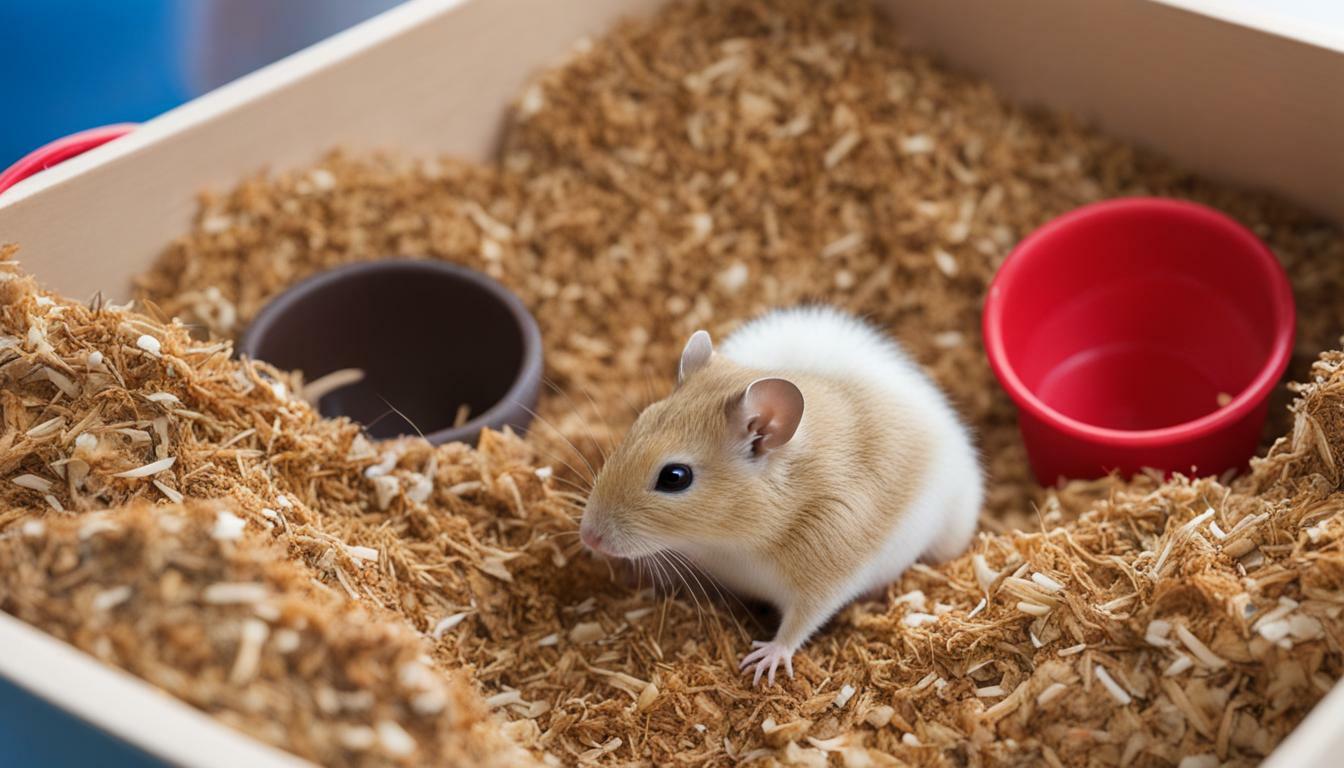Gerbils require proper litter and bedding for their cages to ensure a clean and comfortable environment. While they are naturally clean animals and have a tendency to bury their waste in the substrate, using a litter tray can be more hygienic and easier to maintain. Litter training gerbils is possible, especially when they are young and haven’t developed any bad habits yet.
If you have young gerbils, start by setting up a litter tray filled with sand or chinchilla dust and let them explore and get used to using it. For older gerbils, observe where they commonly go to the bathroom and place the litter tray in that spot. If they struggle, you can place soiled bedding in the litter tray to attract them. Regular cleaning of the litter tray is essential to prevent odors and keep it inviting for the gerbils.
Choosing the right bedding is also important for gerbil owners. Good options include hay, carefresh or cardboard shavings, and shredded paper. These materials provide insulation, comfort, and opportunities for burrowing, which are essential for gerbil well-being. However, it’s important to avoid certain bedding options that can be harmful to their health, such as pine and cedar bedding, which can cause respiratory problems. Newspaper and fluffy bedding should also be avoided due to toxicity and entanglement hazards.
- Proper litter and bedding are necessary for gerbils to maintain a clean and comfortable environment in their cages.
- Gerbils can be litter trained, especially when they are young and haven’t developed bad habits yet.
- Setting up a clean litter tray with sand or chinchilla dust can help encourage gerbils to use it.
- Regular cleaning of the litter tray is essential to prevent odors and maintain hygiene.
- Choosing the right bedding, such as hay, carefresh or cardboard shavings, and shredded paper, is important for gerbil comfort and burrowing opportunities.
Understanding Gerbil Bedding Requirements
Gerbils have specific requirements for bedding in their cages to create a comfortable and stimulating environment. Proper bedding is essential for their well-being as it provides insulation, comfort, and opportunities for burrowing. By understanding their bedding needs, you can ensure that your gerbils thrive in their habitat.
When choosing bedding for your gerbils, it is important to consider their natural behaviors and preferences. Gerbils are burrowing animals, so providing them with a substrate that allows them to dig and tunnel is crucial. Bedding materials such as hay, carefresh or cardboard shavings, and shredded paper are excellent options. These materials not only provide a soft and cozy surface for your gerbils but also mimic their natural habitats.
It is important to note that some bedding options should be avoided. Pine and cedar bedding, commonly used for other small animals, can release aromatic oils that can cause respiratory problems in gerbils. Similarly, newspaper and fluffy bedding can pose toxicity and entanglement hazards. Therefore, it is best to steer clear of these materials to ensure the health and safety of your furry friends.
To keep your gerbil’s cage fresh and clean, litter training can be a valuable practice. Litter training helps minimize mess and odor by encouraging your gerbils to use a designated litter tray. It is easier to litter train gerbils when they are young and haven’t developed any bad habits. By placing a litter tray filled with sand or chinchilla dust in their cage and letting them get used to using it, you can establish good litter habits. For older gerbils, observe where they commonly go to the bathroom and place the litter tray in that spot. If they struggle with using the tray, try placing soiled bedding from their preferred spot into the litter tray to help guide them.
The Importance of Proper Gerbil Cage Substrate
Gerbils are active and curious creatures that require mental and physical stimulation. Providing them with suitable bedding not only ensures their comfort but also stimulates their natural instincts. A soft and burrow-friendly substrate allows gerbils to engage in natural behaviors such as digging, tunneling, and foraging. This not only promotes physical exercise but also provides mental enrichment, preventing boredom and its associated negative behaviors.
As responsible gerbil owners, it is essential to understand and meet their bedding requirements. By choosing the right bedding materials, introducing litter training, and maintaining a clean and hygienic environment, you can create an optimal habitat for your gerbils to thrive.

| Bedding Option | Pros | Cons |
|---|---|---|
| Hay | Soft and comfortable, mimics natural habitat | May not provide enough insulation |
| Carefresh or Cardboard Shavings | Soft, absorbent, and odor-controlling | Can be expensive |
| Shredded Paper | Economical and readily available | May not provide sufficient burrowing opportunities |
Table: Recommended Gerbil Bedding Options
In conclusion, investing in suitable bedding for your gerbils is crucial for their comfort, health, and overall well-being. By understanding their bedding requirements, providing appropriate materials, and implementing litter training, you can create an optimal gerbil habitat. Remember to avoid certain bedding options that may pose risks to your gerbil’s health. With proper care and attention to their bedding needs, your gerbils will thrive in their enriched environment.
Choosing the Best Bedding for Gerbils
Selecting the right type of bedding is crucial for ensuring the well-being of your gerbil. Good bedding provides insulation, comfort, and an opportunity for burrowing, which are all important for a gerbil’s natural behaviors and overall happiness. When choosing bedding for your gerbil, consider options that are safe, absorbent, and easy to clean.
One popular choice is hay, which is not only safe for gerbils but also provides a soft and cozy environment for them to nest and burrow in. Carefresh or cardboard shavings are another excellent option as they are dust-free, absorbent, and environmentally friendly. Shredded paper is also commonly used and can be easily replaced when soiled.
It’s important to avoid certain bedding options that can be harmful to gerbils. Pine and cedar bedding should be avoided as they can release aromatic compounds that may cause respiratory problems for your little furry friend. Newspaper and fluffy bedding may also seem appealing, but they can be toxic and pose entanglement hazards.
Remember that gerbils have sensitive respiratory systems, so it’s best to opt for bedding choices that are safe and promote a healthy habitat. By providing the right bedding, you’re creating a comfortable and hygienic environment that will contribute to your gerbil’s overall well-being.
Recommended Bedding Options for Gerbils
| Bedding Option | Benefits |
|---|---|
| Hay | Soft, cozy, and allows for burrowing |
| Carefresh or Cardboard Shavings | Dust-free, absorbent, and environmentally friendly |
| Shredded Paper | Easily replaced when soiled |
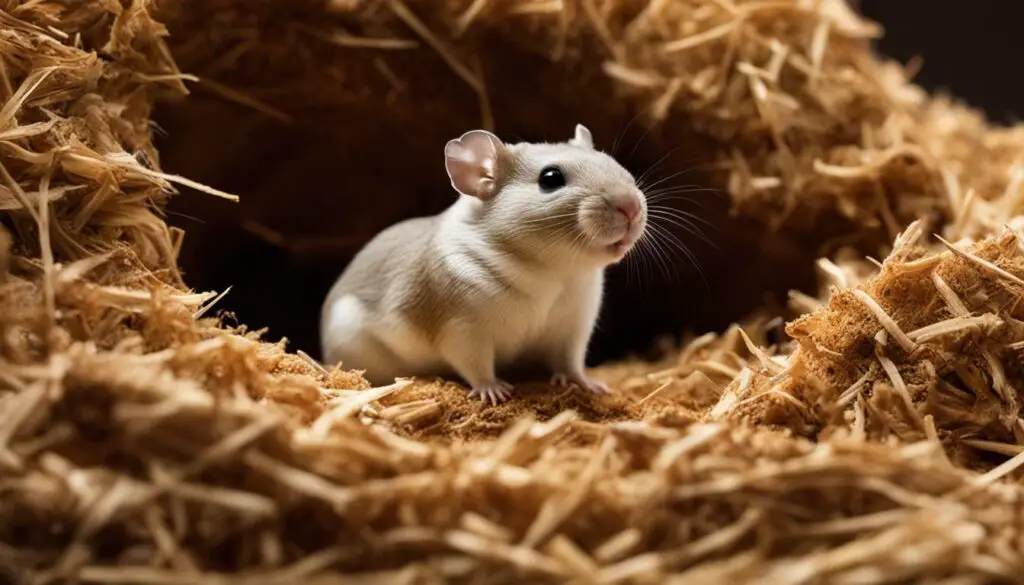
The Importance of Litter for Gerbils
Litter plays a vital role in maintaining a clean and odor-free environment for gerbils. While gerbils are naturally clean animals and tend to bury their waste in the bedding, using a litter tray can provide a more hygienic solution. Proper litter usage can prevent the accumulation of waste in the cage and help control odors. It also makes cleaning the cage easier and more efficient.
When it comes to litter training gerbils, starting early is key. Young gerbils can be easily trained to use a litter tray filled with sand or chinchilla dust. By providing them with a designated bathroom area, you can encourage good habits from the beginning. Older gerbils may require a bit more patience and observation. Observe where they commonly go to the bathroom and place the litter tray in that spot. If they struggle with the concept, you can place some soiled bedding in the litter tray to provide a familiar scent and further encourage them to use it.
Regular cleaning of the litter tray is essential to maintain its hygiene and appeal to gerbils. Remove soiled litter and replace it with fresh litter regularly, depending on the amount of waste produced. This will help prevent odors and maintain a pleasant living environment for your gerbils.
| Good Bedding Options for Gerbils | Avoid These Bedding Options |
|---|---|
|
|
When it comes to bedding, there are several good options for gerbils. Hay, carefresh or cardboard shavings, and shredded paper all make suitable bedding choices. These materials provide comfort, absorb moisture, and encourage natural burrowing behaviors. It’s important to choose bedding that is safe and non-toxic for gerbils.
On the other hand, there are bedding options that should be avoided. Pine and cedar bedding can release harmful aromatic compounds that may lead to respiratory problems in gerbils. Newspaper should also be avoided, as the ink can be toxic. Additionally, fluffy bedding materials can pose a risk of entanglement and should be avoided as well.
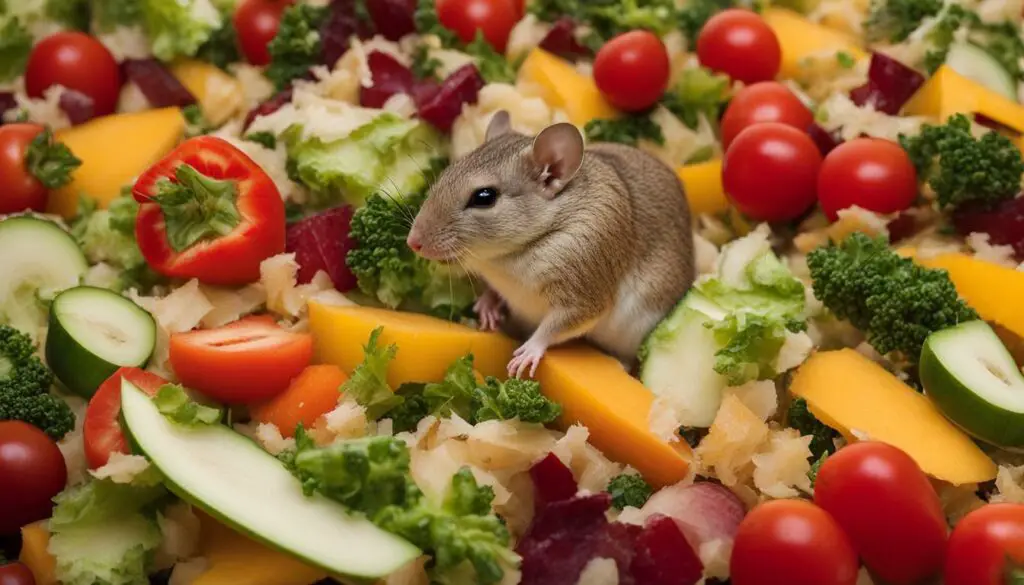
“Using appropriate litter and bedding for gerbils is essential for maintaining their health and well-being. It provides them with a comfortable and hygienic living environment, while also allowing them to exhibit their natural behaviors. By providing a litter tray and choosing suitable bedding materials, you can ensure that your gerbils are happy and healthy.”
Litter Training Gerbils
Litter training can be beneficial for gerbils, especially when started at a young age. It helps maintain cleanliness in their habitat and reduces the frequency of bedding changes. Whether you have a new gerbil or an older one, litter training can be accomplished with a few simple steps.
To begin, set up a litter tray in the gerbil’s cage and fill it with sand or chinchilla dust. Place the tray in an area where the gerbil commonly goes to the bathroom. If you’re unsure, observe their behavior for a few days to identify their preferred spot. You can also sprinkle some soiled bedding in the tray to encourage them to use it. Gerbils are naturally clean animals and often prefer to use a designated area for their waste.
It’s important to clean the litter tray regularly to prevent odors and maintain a hygienic environment. Remove any soiled litter and replace it with fresh sand or chinchilla dust. This will ensure that the gerbil continues to use the tray and minimize the risk of accidents elsewhere in the cage.

| Benefits of Litter Training Gerbils |
|---|
| 1. Improved hygiene: Litter training helps contain gerbil waste in a specific area, making it easier to clean and maintain a fresh environment. |
| 2. Reduced bedding changes: By using a litter tray, you can minimize the frequency of bedding replacements, saving time and money on supplies. |
| 3. Odor control: Concentrating gerbil waste in a litter tray helps control odors, making the habitat more pleasant for both you and your pet. |
Remember, patience is key when litter training gerbils. It may take some time for them to become accustomed to using the tray consistently. With a little effort and consistency, you can successfully litter train your gerbil and enjoy a cleaner, more hygienic habitat.
Proper Placement of Litter Trays
Proper placement of litter trays can enhance the effectiveness of litter training for gerbils. When setting up a litter tray, observe your gerbils’ behavior and identify the spots where they commonly go to the bathroom. This will help you strategically place the litter tray in their preferred location, increasing the chances of successful litter training. If your gerbils have not yet established a specific spot, you can guide them by placing the litter tray in a convenient and easily accessible area within their cage.
Remember to make the litter tray inviting for your gerbils. You can achieve this by placing soiled bedding or waste from other areas of the cage into the litter tray. Gerbils have a strong sense of smell, and the presence of their own scent in the tray will encourage them to use it. Additionally, consider placing the litter tray away from their food and water sources, as gerbils prefer to keep their eating and elimination areas separate.
By strategically placing litter trays, you can create a designated toileting area for your gerbils and improve their litter training progress. This not only promotes better hygiene within their cage but also makes cleaning easier for you. A clean and well-maintained litter tray will help prevent odors and ensure a healthier environment for your furry friends.
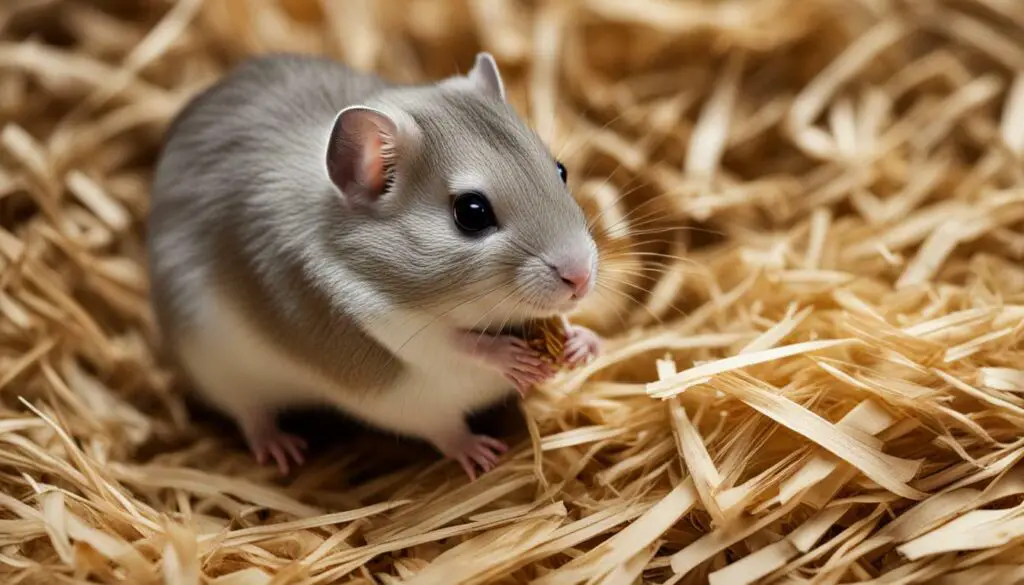
Remember, litter training is most effective when gerbils are young and haven’t developed any bad habits. However, even older gerbils can be successfully litter trained with patience and consistency. By providing the right litter tray placement and maintaining a clean and inviting environment, you can support your gerbils’ natural instincts and keep their cage fresh and sanitary.
Maintaining a Clean Litter Tray
Regular maintenance of the litter tray is essential for your gerbil’s health and well-being. Cleanliness ensures that your gerbil’s environment remains hygienic, odor-free, and inviting for them to use. Follow these guidelines to effectively maintain your gerbil’s litter tray:
- Remove soiled bedding and waste from the litter tray daily. Dispose of it properly to prevent the spread of bacteria and odors.
- Replace the litter in the tray every few days or as needed. This helps maintain a clean and fresh substrate for your gerbil.
- Wash the litter tray with mild soap and warm water at least once a week. Rinse it thoroughly to remove any soap residue before refilling it with fresh litter.
- Observe your gerbil’s behavior and adjust the frequency of cleaning accordingly. Some gerbils may be more fastidious with their litter boxes, while others may require more frequent cleaning.
By ensuring regular maintenance of the litter tray, you create an environment that promotes your gerbil’s well-being and reduces the risk of health issues. Remember, a clean and comfortable living space is crucial for their overall happiness and longevity.
Recommended Gerbil Bedding Options
When choosing bedding for your gerbil’s cage, it is important to consider their comfort and safety. Here are some recommended bedding options:
| Bedding Option | Benefits |
|---|---|
| Hay | Provides natural and soft bedding for gerbils to burrow and nest in. It is readily available and affordable. |
| Carefresh or Cardboard Shavings | These options are highly absorbent, keeping the cage drier for longer periods. They are also dust-free, reducing the risk of respiratory issues. |
| Shredded Paper | Recycled paper bedding is another safe and comfortable option for gerbils. It is also cost-effective and easy to find. |
Remember to avoid using pine and cedar bedding as they can lead to respiratory problems in gerbils. Additionally, newspaper and fluffy bedding should be avoided due to their potential toxicity and entanglement hazards.
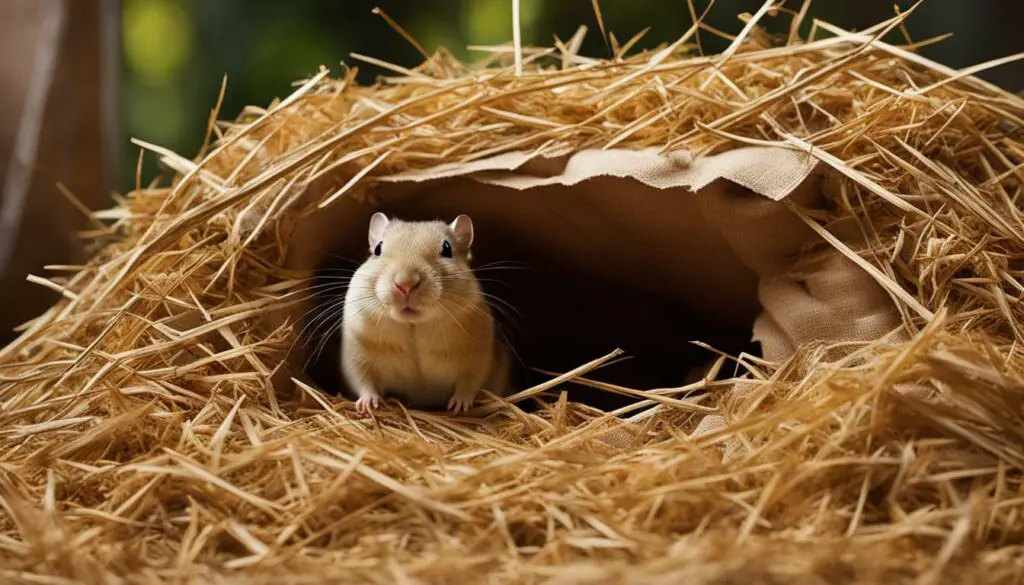
Providing appropriate bedding and maintaining a clean litter tray are crucial aspects of gerbil care. By following these guidelines, you can ensure a comfortable, hygienic, and safe environment for your gerbil to thrive in.
Recommended Gerbil Bedding Options
When it comes to choosing bedding for your gerbil, certain options are more suitable than others. Good bedding not only provides comfort for your pet, but it also helps maintain proper hygiene in their cage. Here are some recommended bedding options that will keep your gerbil happy and healthy:
- Hay: Hay is a popular choice for gerbil bedding as it allows them to burrow and create cozy nests. Timothy hay or orchard grass are great options, but be sure to avoid dusty or moldy hay.
- Carefresh or Cardboard Shavings: These bedding materials are soft, absorbent, and dust-free, making them comfortable for your gerbil. They are also odor-controlling and provide insulation for your pet’s cage.
- Shredded Paper: Recycling old newspaper or using shredded paper provides a cost-effective bedding option. Just be sure to use non-toxic ink and avoid glossy or colored paper.
It’s important to steer clear of bedding options that can be harmful to your gerbil’s health. Pine and cedar bedding should be avoided as they can release aromatic oils that may cause respiratory problems. Additionally, newspaper and fluffy bedding pose risks due to toxicity and entanglement hazards.
Table: Gerbil Bedding Options
| Bedding Type | Pros | Cons |
|---|---|---|
| Hay | Allows burrowing and nesting | May become soiled quickly |
| Carefresh or Cardboard Shavings | Soft, absorbent, and odor-controlling | Slightly more expensive |
| Shredded Paper | Cost-effective and readily available | May require more frequent changes |
By offering your gerbil a comfortable and safe bedding option, you are providing them with a cozy and sanitary living environment. Remember to regularly clean the bedding and litter tray to prevent odor buildup and maintain optimal hygiene. Your gerbil will appreciate the effort, and you’ll enjoy having a fresh and happy pet.
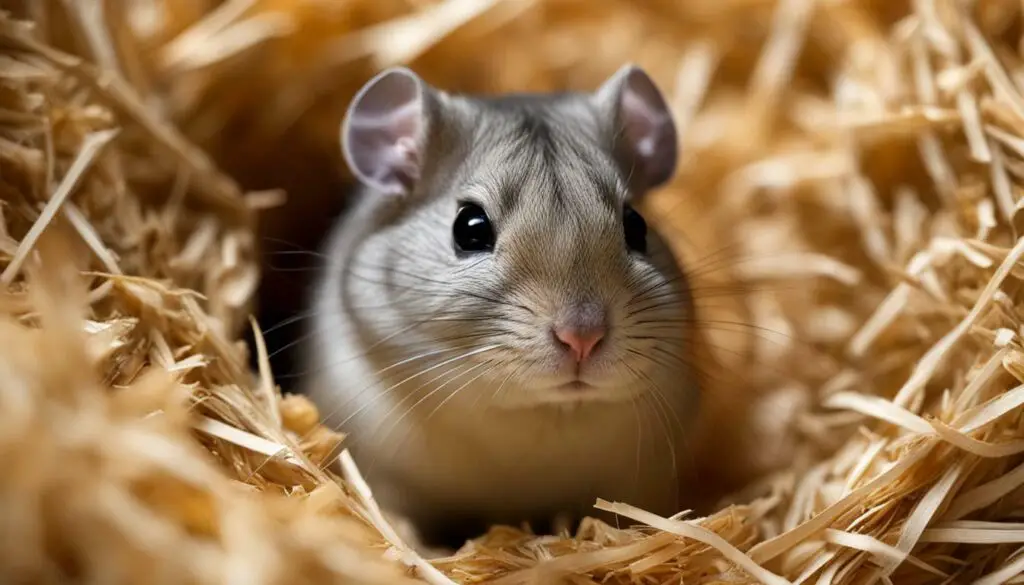
While there are many bedding options available, some should be avoided for the safety of your gerbil. One such option is newspaper bedding. Although it may seem like a convenient and cost-effective choice, newspaper ink can be toxic to gerbils when ingested or inhaled. It’s best to steer clear of using newspaper as bedding in your gerbil’s cage to prevent any potential health issues.
Another bedding option to avoid is fluffy bedding, such as cotton or polyester materials. While it may seem cozy and soft, fluffy bedding can pose entanglement hazards for gerbils. These curious creatures may unintentionally get tangled up in the material, causing potential injury or discomfort. Therefore, it’s important to prioritize the safety of your gerbil by opting for alternative bedding options.
Instead, consider using safer bedding materials like hay, carefresh or cardboard shavings, and shredded paper. These options provide a comfortable and suitable substrate for your gerbil’s habitat. Remember, gerbils love to burrow and nest, so choosing bedding that allows for these natural behaviors is crucial for their overall well-being.
| Bedding Option | Benefits | Drawbacks |
|---|---|---|
| Hay | – Provides insulation and natural scent – Encourages foraging and gnawing |
– May become soiled more quickly – Some gerbils may not have a strong preference for hay |
| Carefresh or Cardboard Shavings | – Soft and comfortable bedding option – Absorbs odors well – Dust-free |
– Can be more expensive than other options – May need to be replaced regularly |
| Shredded Paper | – Economical option – Easily accessible – Provides nesting material and enrichment |
– May become soiled quickly – Requires more frequent cleaning |

By avoiding unsuitable bedding options and opting for safe alternatives, you can create a comfortable and hygienic environment for your gerbil. Remember to regularly clean the bedding and litter tray to maintain optimal hygiene. Providing appropriate bedding not only enhances the well-being of your gerbil but also contributes to a happy and healthy pet.
Saving on Bedding Expenses through Litterbox Training
Litterbox training your gerbil can have both financial and practical advantages. Not only can it help you save on bedding expenses, but it also allows you to keep your gerbil’s cage fresh and clean. By teaching your gerbil to use a litter tray, you can minimize the amount of bedding that needs to be replaced regularly.
To start litter training your gerbil, set up a litter tray filled with sand or chinchilla dust. For young gerbils, let them explore the tray and get used to the texture. If you have older gerbils, observe where they commonly go to the bathroom and place the litter tray in that spot. If they struggle to use the tray, you can try placing some soiled bedding in it to encourage them.
It’s important to clean the litter tray regularly to prevent odors and keep it inviting for your gerbil. Remove any soiled litter and replace it with fresh sand or dust. By maintaining a clean litter tray, you can ensure that your gerbil will continue to use it as their designated bathroom area.
When it comes to choosing bedding for your gerbil, there are several options to consider. Good choices include hay, carefresh or cardboard shavings, and shredded paper. These materials provide comfort and can be easily burrowed into, satisfying your gerbil’s natural instincts. However, it’s important to avoid pine and cedar bedding, as they can cause respiratory problems in gerbils. Similarly, newspaper and fluffy bedding should be avoided due to the risk of toxicity and entanglement hazards.
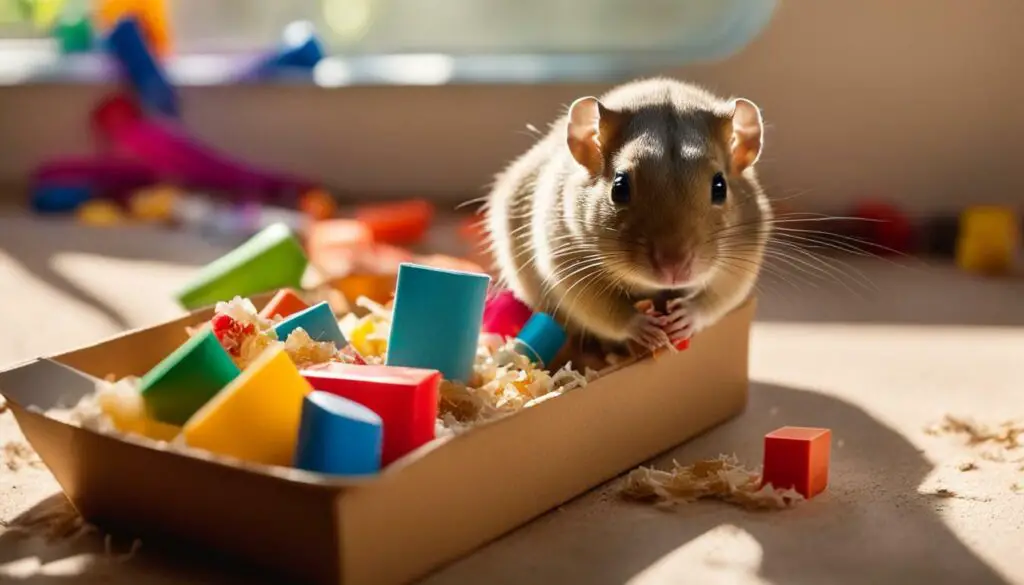
| Recommended Bedding Options | Avoid These Bedding Options |
|---|---|
|
|
Conclusion
Litterbox training your gerbil not only helps you save on bedding expenses but also promotes a cleaner and more hygienic environment for your pet. By providing a designated area for your gerbil to relieve themselves, you can maintain a fresh-smelling cage and reduce the amount of bedding that needs to be replaced. Remember to choose suitable bedding materials that promote comfort and avoid those that can be harmful. By following these guidelines, you can ensure the well-being of your gerbil while also enjoying the benefits of cost-effective litterbox training.
Creating an Optimal Gerbil Habitat
Providing a well-designed habitat is essential for the overall well-being of your gerbil. In addition to litter and bedding, there are several factors to consider when creating an optimal environment for your furry friend. Let’s explore some key aspects:
Cage Size
Gerbils are active animals that require plenty of space to roam and explore. It is recommended to provide a cage that is at least 20 inches long and 12 inches wide for a single gerbil, with additional space for every additional gerbil in the same habitat. A larger cage will allow your gerbils to engage in their natural behaviors such as burrowing, climbing, and running. Consider providing multiple levels and platforms to create an enriching and stimulating living space.
Enrichment Items
Gerbils thrive when provided with a variety of toys and enrichment items. These can include tunnels, chew toys, exercise wheels, and hideouts. These items not only provide mental stimulation but also help keep your gerbil active and entertained. Be sure to regularly rotate and introduce new toys to keep their environment fresh and exciting.
Temperature Control
Gerbils are sensitive to extreme temperatures, so it’s important to keep their habitat within a comfortable range. The ideal temperature for gerbils is between 65 to 75 degrees Fahrenheit (18 to 24 degrees Celsius). Avoid placing the cage in direct sunlight or near drafts. Monitor the temperature regularly, especially during hot summer months or cold winters, and make adjustments as needed to ensure your gerbil’s well-being.
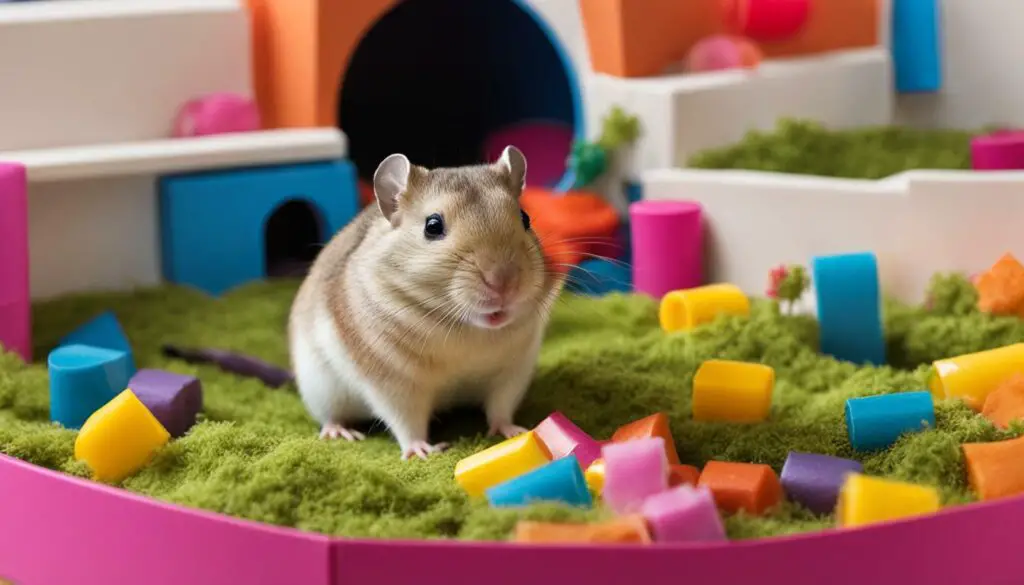
By following these guidelines and providing your gerbil with a spacious, enriching, and temperature-controlled habitat, you can create an optimal environment that promotes their happiness and overall health.
| Key Considerations for an Optimal Gerbil Habitat | Description |
|---|---|
| Cage Size | Gerbils require ample space to move, explore, and engage in natural behaviors. |
| Enrichment Items | Provide toys and items that stimulate their senses and keep them mentally and physically active. |
| Temperature Control | Maintain a comfortable temperature range to ensure your gerbil’s well-being. |
Conclusion
Ensuring that your gerbil has proper litter and bedding is crucial for both its comfort and hygiene. Gerbils may naturally bury their waste in the substrate, but using a litter tray can create a more sanitary environment. Litter training your gerbils is possible, especially when they are young and haven’t developed any bad habits. Set up a litter tray with sand or chinchilla dust and let them get accustomed to using it. For older gerbils, observe where they commonly go to the bathroom and place the litter tray in that spot. If they struggle, you can place soiled bedding in the tray to encourage usage.
Cleaning the litter tray regularly is important to prevent odors and maintain a welcoming space for your gerbils. As for bedding options, there are several suitable choices to consider. Hay, carefresh or cardboard shavings, and shredded paper are all good options that provide comfort and insulation. However, it’s important to avoid pine and cedar bedding, as they can cause respiratory problems for gerbils. Additionally, steer clear of newspaper and fluffy bedding, as they can be toxic or pose entanglement hazards.
Litterbox training your gerbils not only contributes to a cleaner cage environment but also saves on bedding expenses. By teaching them to use a litter tray, you can reduce the amount of bedding needed and keep their living area fresh and tidy. Remember, creating an optimal gerbil habitat involves more than just litter and bedding. Consider factors such as cage size, enrichment items, and temperature control to ensure the well-being of your furry friends.
In conclusion, providing your gerbil with appropriate litter and bedding is essential. By promoting good hygiene and creating a comfortable environment, you are enhancing your gerbil’s overall quality of life. So, make sure to select the right litter and bedding options, maintain a clean litter tray, and consider litterbox training to keep your gerbil happy and healthy.
FAQ
Q: Do gerbils need litter and bedding?
A: Yes, gerbils do need litter and bedding to maintain a clean and sanitary environment.
Q: Can gerbils be litter trained?
A: Yes, gerbils can be litter trained, especially when they are young and haven’t learned bad habits.
Q: How do I litter train my gerbils?
A: To litter train young gerbils, set up a litter tray with sand or chinchilla dust and let them get used to it. For older gerbils, observe where they commonly go to the bathroom and place the litter tray there.
Q: How often should I clean the litter tray?
A: It is important to clean the litter tray regularly to prevent odors and keep it inviting for the gerbils. Clean it as needed, typically every few days.
Q: What are the recommended bedding options for gerbils?
A: Good bedding options include hay, carefresh or cardboard shavings, and shredded paper. Pine and cedar bedding should be avoided due to potential respiratory problems.
Q: Why should I avoid using newspaper and fluffy bedding?
A: Newspaper can be toxic, and fluffy bedding can pose entanglement hazards for gerbils.
Q: Can litterbox training save on bedding expenses?
A: Yes, litterbox training gerbils can save on bedding expenses and help keep their cage fresh and clean.

